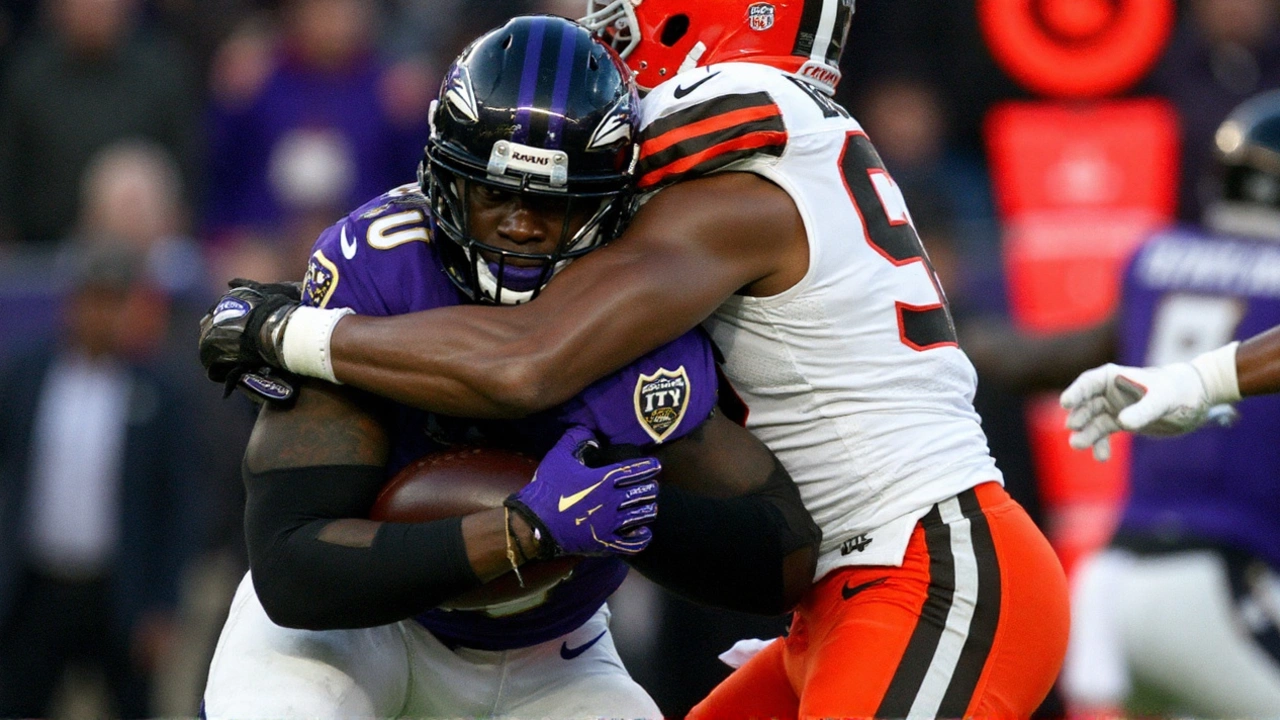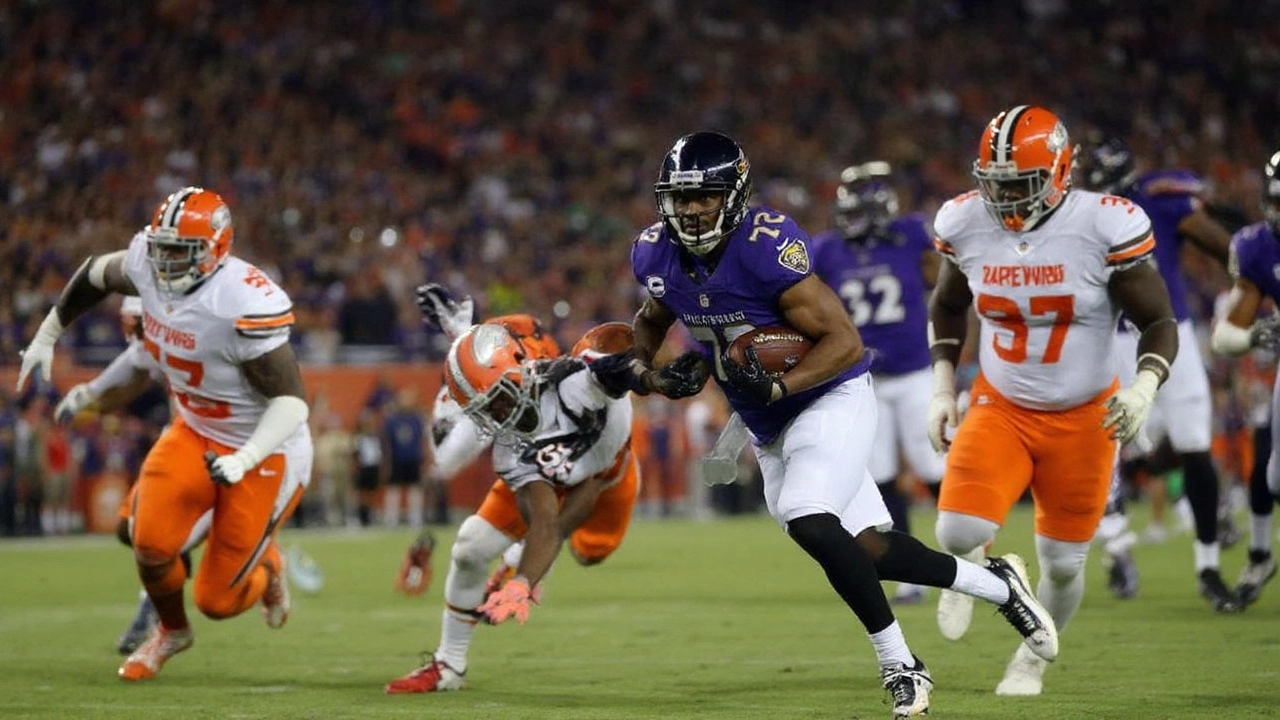What worked — and why it mattered
The score says blowout, but the first half told a different story. The Cleveland Browns trailed just 10-3 at the break in one of the league’s toughest road environments, and they did it by taking away the thing Baltimore usually leans on: the run. Cleveland stacked gaps, tackled cleanly, and forced the Ravens to win through the air. Against Lamar Jackson and a ground game that normally tilts the field, that’s not nothing.
Two things stood out on defense early. First, Cleveland’s front read option looks well and stayed disciplined on the edges, which limited the chunk runs that usually break Baltimore games open. Second, the disguised coverages on early downs nudged the Ravens into longer second and third downs, which cut into play-action timing. That mix gave the Browns’ offense a chance to grind their way into the game.
Even with a hostile crowd and constant noise at M&T Bank Stadium, there was poise. The Browns didn’t panic when possessions got muddy. They played field position, avoided the early back-breaking mistake, and leaned on a defense that kept the lid on explosive runs. For a team adjusting on the fly in Week 2, composure mattered.
Joe Flacco’s return to Baltimore was never going to be subtle. He managed the first half with veteran calm, took what was there, and didn’t let the moment speed him up. The timing routes to the outside and a couple of rhythm throws between the hashes hinted at a plan: be efficient, avoid negative plays, and wait for a short field. In the first 30 minutes, that plan kept Cleveland within striking distance.
There were also special-teams moments that quietly helped the script early. Punts that pinned Baltimore back, clean operation on kicks, and decent coverage kept the game from tilting before halftime. It wasn’t flashy, but it mattered to the flow. When you play Baltimore, you need that.
Big picture, the early defensive blueprint is repeatable. Gap integrity against mobile quarterbacks, contain-first edges, and patient zone looks forced the Ravens to be methodical. That’s how you survive in the AFC North when you’re not rolling on offense yet. It’s a foundation to build on — if the offense and the second-half adjustments catch up.

What broke — and where the Browns go from here
Everything that held up for 30 minutes slipped after halftime. Baltimore outscored Cleveland 31-7 from the break on, and the game turned fast. The turning point wasn’t subtle: a Joe Flacco interception snagged by Ravens rookie corner Nate Wiggins flipped field position and mood. It didn’t just cost Cleveland points. It gave Baltimore a short field, juiced the crowd, and forced the Browns to chase.
That’s the part that stings. Cleveland had Baltimore playing left-handed early, then handed them momentum with a giveaway. These are the plays that swing AFC North games. When the Ravens get a short field, they cash in more often than not, and they did again here.
Protection was a problem that never really went away. Flacco faced constant pressure, had to escape the pocket more than you’d want, and too many snaps turned into survival drills. The issues from Week 1 carried over: communication against simulated pressure, late help to the edge, and interior rushers walking the pocket back. You can’t run an offense on schedule when your quarterback can’t hit the back foot in rhythm.
The downstream effect showed up in situational football. Third downs got longer. Shot plays were out. Short throws got jumped by corners sitting on routes. The run game didn’t scare Baltimore out of its pressures, and the Browns couldn’t consistently punish them with quick game or screens. Without balance, Baltimore’s front seven could tee off.
Penalties and missed chances added fuel. A drive-starter flag here, a hold on the edge there, and a manageable series turned into a punt. Defensively, one or two missed tackles turned modest gains into chains-moving plays. It wasn’t a meltdown in one spot — it was a series of small wounds that added up, exactly the kind of accumulation that turns a one-score game into a rout.
Halftime adjustments? Baltimore made them. Cleveland didn’t get enough out of theirs. The Ravens sped up their pass game to neutralize the rush and mixed in motion to stress the flats. Cleveland’s answers were slower to arrive. What worked in the first half — clogging lanes, showing two-high shells to muddy reads — didn’t hit as hard when Baltimore leaned into quick-hitters and tempo. That’s where the game got away.
There’s also the missing “closer” feel on offense. Trailing 10-3 at half on the road is survivable if you come out with a sharp script. Instead, Cleveland’s opening second-half sequences lacked rhythm. First downs were scarce, and the defense got stuck back on the field with little rest. Complementary football went out the window, and that’s how a game snowballs in the third quarter.
So what now at 0-2? Historically, teams in this hole face long odds. The good news: the path to competence is clear and fixable. Start with protection. Help the tackles with chips and tight splits. Call more play-action on early downs to slow the rush. Build in quicker answers — slants, sticks, flat routes — to move the chains and discourage heat. You don’t have to be explosive right away; you have to be efficient.
Next: clean up ball security. Turnovers are drive killers, but they’re also mood killers. Protecting the ball isn’t just about the quarterback; it’s about receivers finishing through contact, backs covering up in traffic, and coaches avoiding low-percentage calls when a game is teetering. The Ravens pounced on a mistake and never looked back. That’s the blueprint opponents will copy until the Browns make them pay.
Defensively, keep the core plan but add a few changeups. Mix in simulated pressures that look like heat and drop out. Steal a takeaway with a trap coverage on a money down. The front did enough early to earn a short field or two from the offense. Don’t drift from that identity. Stay disciplined against the run, then hunt throws when it’s time.
Discipline and details need a bump, too. Pre-snap communication against noise. Fewer drive-starter penalties. Cleaner landmarks on scramble drills. These aren’t highlight items, but they decide close games — and keep tough ones from spiraling.
What should fans take from 41-17? There’s a workable defensive identity against mobile quarterbacks. The roster didn’t fold in a hostile building. But the second-half gap in adjustments, the protection breakdowns, and the turnover that flipped the day are real problems. Fix those three, and the ceiling changes. Leave them alone, and the hole gets deeper in a division that punishes mistakes.
There’s pressure now, no way around it. The AFC North won’t wait, and opponents have the tape: heat up the pocket, sit on underneath routes, and dare Cleveland to win clean in the fourth quarter. The response starts with coaching — faster counters, better protection plans — and continues with players owning the details. Week 2 was a lesson in margins. The Browns were in it, until they weren’t. The job now is to make sure a solid half becomes a full game before the season’s math turns harsh.
